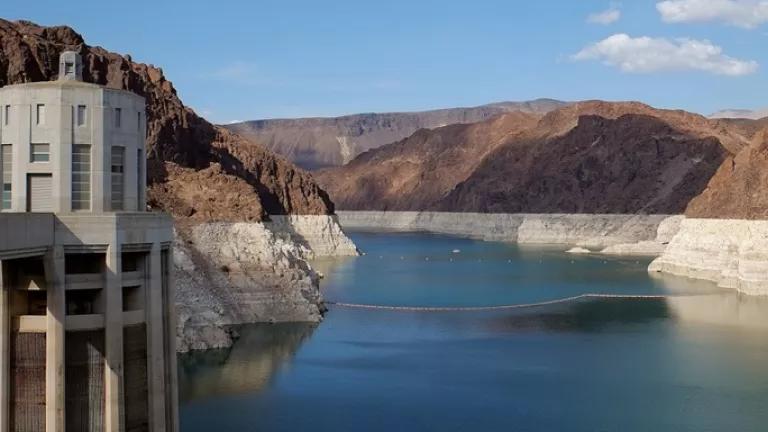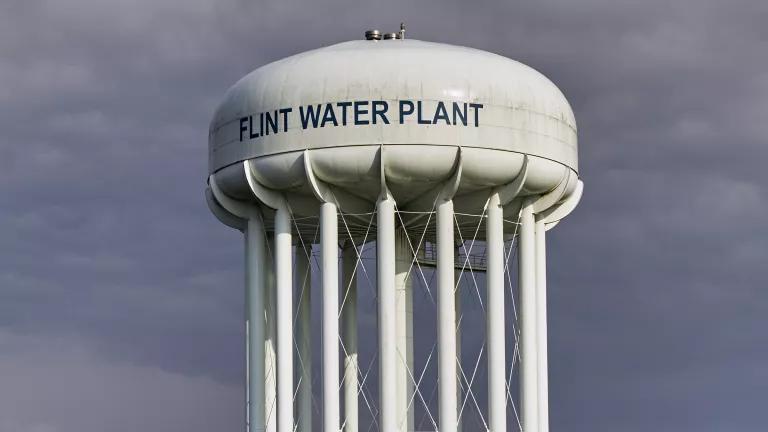NRDC Sets Region Specific Water Targets for Each Office
NRDC has seen a steady decline in total water usage institution-wide and has taken steps to advance water stewardship.

Severe drought threatens Hoover dam reservoir and water for western US.
Guest post written by Chris LaCour
Water is an essential resource for sustaining life on our planet, but it is a limited resource; what we have is all we get. Climate change and overconsumption around the globe lead to predictions of freshwater shortages in less than 50 years. An Earth’s Future study found that nearly half of the United States’ fresh water supplies will not meet consumer demand by 2071. Part of the solution is reducing agricultural irrigation (in most regions, over 70 percent of freshwater is used for agriculture), increasing water efficiency, and improving water catchment health.
These findings are reflected in NRDC’s external work and the organizational internal NRDC Sustainable Operations Plan which seeks to reduce the organization's water and energy consumption and waste generation. Specifically, Vision 2 of the NRDC Sustainable Operations Plan is to increase water efficiency. This vision includes three approaches that serve as a clear guide for choosing courses of action: (1) align with water use needs of the region, (2) minimize potable water supply by increasing efficiency of water fixtures, and (3) recycle greywater and minimize waste water requiring treatment. Since water usage monitoring began in 2014, we have made progress on approaches 2 and 3 with NRDC seeing a steady decline in total and per capita water usage institution-wide. This is mainly due to utilizing water efficient fixtures that align with the NRDC Design and Construction Protocols.
To tackle Approach 1 and create unique plans for each office, we referenced the CEO Water Mandate, a special initiative of the United Nations to address global water challenges and advance water stewardship that outlines “Setting Site Water Targets Informed by Catchment Context”. Each office has its own operational dependencies and water system catchments challenges due to its unique location. To understand these differences, we accessed the water municipality information and connected with relevant non-profit organizations in each area. The relevant non-profit organizations were water conservation organizations and local community groups who had established advocacy and targets for what they deemed water priorities.
To create each office’s specific and measurable 2030 water targets, we compared these findings to our current baselines to assess the improvements needed to achieve the desired conditions for each water catchment.
New York, NY
Our headquarters gets its water from the Catskill/Delaware and the Croton watersheds. These watersheds face pollution from stormwater run-off and filtration interference from sediment transported within the watershed. New York City sewer systems are also overwhelmed during storms and heavy downpours when basins are clogged with debris and water collects and sits on the streets. The city has a Green Infrastructure Plan in place to help reduce overflows and the state Department of Environmental Conservation manages floodplains to help reduce the risk of New Yorkers being adversely affected by both coastal and inland flooding. NRDC Targets:
- Advocate for green infrastructure that reduces stormwater, flooding, and erosion runoff.
- Ensure the NRDC Procurement Policy avoids PFAs, lead, and chromium-6.
- If feasible, implement onsite rainwater harvesting and stormwater runoff reduction.
Washington, D.C.
This office gets its water from the Potomac River at Great Falls and Little Falls; the Washington Aqueduct withdraws about 140 million gallons each day and is treated at the Delacarlia Reservoir. However, D.C. also operates with both separate and combined sewer systems. These combined systems, when overwhelmed by stormwater, can lead to high bacteria levels and various inorganic debris in receiving waters. DC Water, the group that manages and operates these systems, is currently working towards installing a new tunnel system to phase out these overflows and prevent sewage from being released into the river. NRDC Targets:
- Oversee litigation and project development related to stormwater management in D.C. and the Chesapeake Bay Watershed.
- Advocate for strong stormwater permits in D.C. and Chesapeake Bay Watershed via the Chesapeake Chesapeake Bay Choose Clean Water workgroup and the Chesapeake Bay Clean Up Blueprint
Chicago, IL
In Chicago, sewage backups and combined sewage overflows (CSOs) into waterways are the main water challenges facing the city. It is one of the items addressed in the Metropolitan Water Reclamation Department’s Tunnel and Reservoir Plan; the Plan calls for a system of deep, large tunnels designed to reduce flooding and improve water quality in Chicago waterways. However, the project is not scheduled for completion until 2029. NRDC Targets:
- Advocate for strong stormwater permits and funding for green infrastructure projects.
- Ensure the NRDC Procurement Policy avoids PFAs, lead, and chromium-6.

Common items that contain PFAs, the forever chemical.
Bozeman, MT
This small city is facing numerous challenges with water quantity; Bozeman is prone to drought conditions, and is seeing a reduced snowpack due to shifting climate patterns and a population boom. Currently, the Lower Gallatin Watershed Restoration Plan (LGWRP) grant planning is underway to evaluate all proposed restoration projects that provide stream and watershed improvements to help meet a state water quality standard. NRDC Targets:
- Advocate for riparian restoration and soil health to be included as strategies in Montana’s Drought Plan.
- Support local partnerships for strategic watershed management.
San Francisco, CA
Our San Francisco office sources its water from the Hetch Hetchy reservoir via the Tuolumne River. After it reaches the city, all used water is treated by the city’s various treatment plants before being dumped into the bay. Unfortunately, none of this water is reclaimed or recycled for multiple uses, putting a strain on the Tuolumne river flow and negatively impacting native river life (e.g. salmon runs, etc.). SF Public Utilities Commission currently has a Water Reuse grant program which helps to save 30 million gallons of water each that would normally be used for drinking purposes. However, the reclaimed water is non-potable and is only used for steam heating of commercial buildings and hotels. NRDC Targets:
- Advocate for strong stormwater permits and funding for nature-based solutions for stormwater management.
- If feasible, implement an onsite water reclamation system.
Santa Monica, CA
For Santa Monica, the city has seen increased urbanization, which has had a significant impact on riparian and wetland resources of their watershed. It’s estimated that 95% of the historic wetlands have been destroyed in the Santa Monica Bay Watershed Management Area. While the Santa Monica Bay WMA is quite large and diverse, the city of Santa Monica currently obtains about 75% of its water from local groundwater wells within the city and in West LA. NRDC Targets:
- Advocate for strong stormwater permits and funding for nature-based solutions for stormwater management.
- Advocate for the effective spending of Los Angeles’ stormwater tax on green infrastructure stormwater capture projects.
- Advocate for wetland restoration.
- Implement onsite greywater system and reduce stormwater runoff.
Beijing, China
Finally, in Beijing, the city’s number one issue is water scarcity; northern China has seen an ever-increasing population as well as growth in the industrial and agricultural sectors. With all this growth, the region’s limited water resources have gradually been falling. China’s South-North Water Transfer project hopes to remediate much of this scarcity by transferring water from the Yangzte River in the south more than 1000 km north to the Yellow River basin. Beijing currently has very stringent water usage policies in place, with strict requirements on water saving for home appliances and service industries as well as among the highest water tariff among Chinese cities. NRDC Target:
- Advocate to increase use of reclaimed water from wastewater treatment plants for domestic use.
We are grateful for the prioritization of sustainable operations and the ambitious policy work already being done at NRDC and other organizations. As we progress toward our 2030 water targets, we will continue purchasing Water Restoration Certificates from BEF that help balance our water footprint, gallon-for-gallon, and support water security, food security, and environmental benefits.
Our mission to safeguard the Earth is the guiding force in these efforts, and that is why NRDC water targets are accompanied by other institutional targets to achieve zero waste, reduce greenhouse gas emissions, prioritize healthy building, and increase engagement. If this has inspired you to do the same (whether on a small or large scale), please feel free to reach out to sustainability@nrdc.org for guidance on where to start.



